Basque vs Senegalese Community Comparison
COMPARE
Basque
Senegalese
Social Comparison
Social Comparison
Basques
Senegalese
6,979
SOCIAL INDEX
67.3/ 100
SOCIAL RATING
133rd/ 347
SOCIAL RANK
1,684
SOCIAL INDEX
14.4/ 100
SOCIAL RATING
292nd/ 347
SOCIAL RANK
Senegalese Integration in Basque Communities
The statistical analysis conducted on geographies consisting of 52,069,319 people shows a poor negative correlation between the proportion of Senegalese within Basque communities in the United States with a correlation coefficient (R) of -0.174. On average, for every 1% (one percent) increase in Basques within a typical geography, there is a decrease of 0.036% in Senegalese. To illustrate, in a geography comprising of 100,000 individuals, a rise of 1,000 Basques corresponds to a decrease of 35.8 Senegalese.
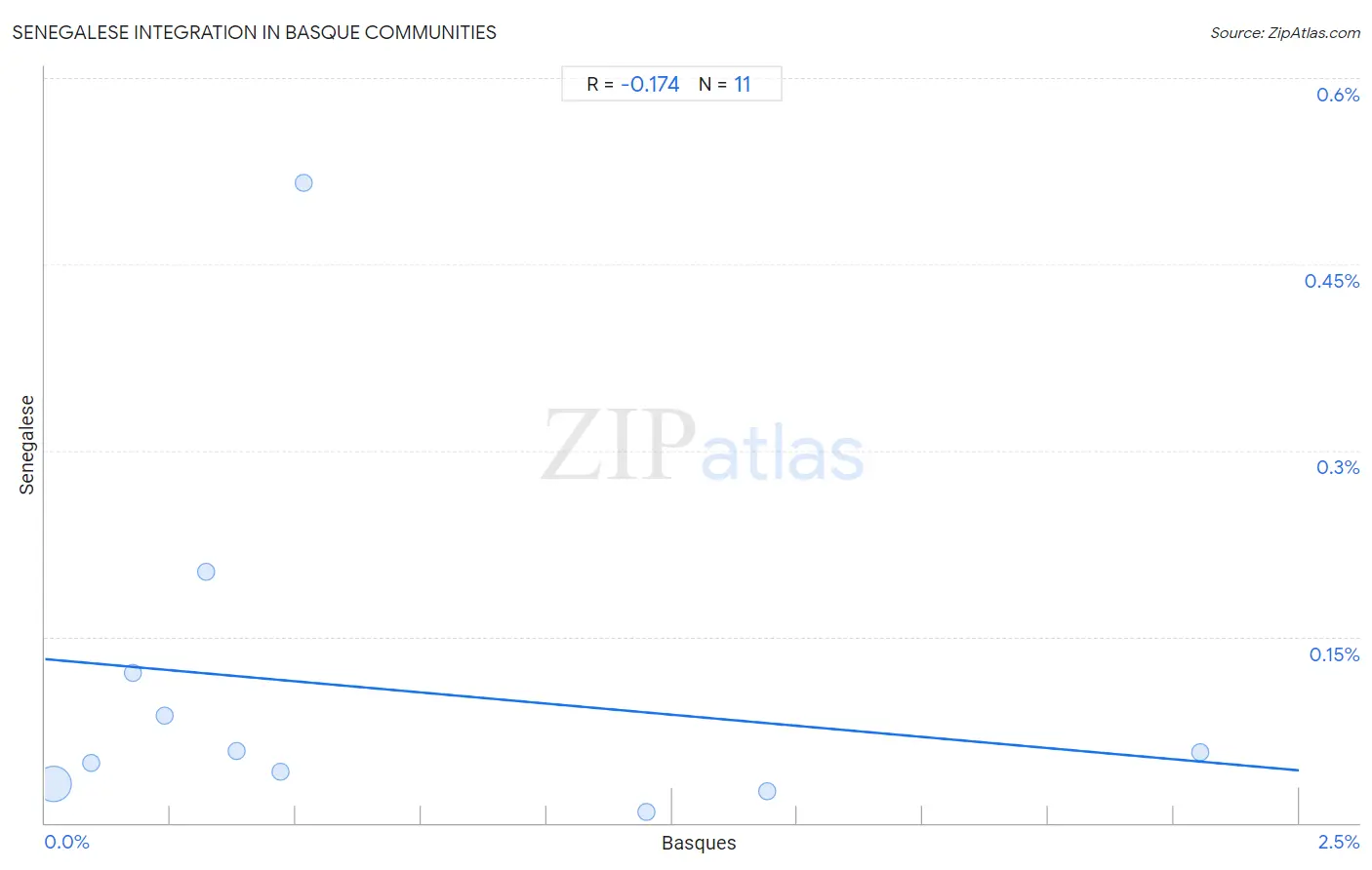
Basque vs Senegalese Income
When considering income, the most significant differences between Basque and Senegalese communities in the United States are seen in wage/income gap (28.8% compared to 20.7%, a difference of 39.4%), householder income ages 45 - 64 years ($103,387 compared to $86,897, a difference of 19.0%), and householder income over 65 years ($62,653 compared to $53,591, a difference of 16.9%). Conversely, both communities are more comparable in terms of median female earnings ($38,352 compared to $39,384, a difference of 2.7%), median earnings ($46,399 compared to $44,373, a difference of 4.6%), and householder income under 25 years ($51,818 compared to $48,953, a difference of 5.9%).

| Income Metric | Basque | Senegalese |
| Per Capita Income | Excellent $45,086 | Tragic $41,000 |
| Median Family Income | Good $104,760 | Tragic $91,475 |
| Median Household Income | Good $87,001 | Tragic $74,999 |
| Median Earnings | Average $46,399 | Tragic $44,373 |
| Median Male Earnings | Good $55,370 | Tragic $49,774 |
| Median Female Earnings | Tragic $38,352 | Fair $39,384 |
| Householder Age | Under 25 years | Fair $51,818 | Tragic $48,953 |
| Householder Age | 25 - 44 years | Good $96,709 | Tragic $82,852 |
| Householder Age | 45 - 64 years | Excellent $103,387 | Tragic $86,897 |
| Householder Age | Over 65 years | Excellent $62,653 | Tragic $53,591 |
| Wage/Income Gap | Tragic 28.8% | Exceptional 20.7% |
Basque vs Senegalese Poverty
When considering poverty, the most significant differences between Basque and Senegalese communities in the United States are seen in receiving food stamps (10.3% compared to 15.4%, a difference of 50.0%), family poverty (8.1% compared to 11.5%, a difference of 40.8%), and child poverty under the age of 16 (14.8% compared to 20.4%, a difference of 37.5%). Conversely, both communities are more comparable in terms of single male poverty (13.0% compared to 13.1%, a difference of 0.37%), single mother poverty (29.5% compared to 31.0%, a difference of 5.1%), and female poverty among 18-24 year olds (21.7% compared to 23.0%, a difference of 6.1%).
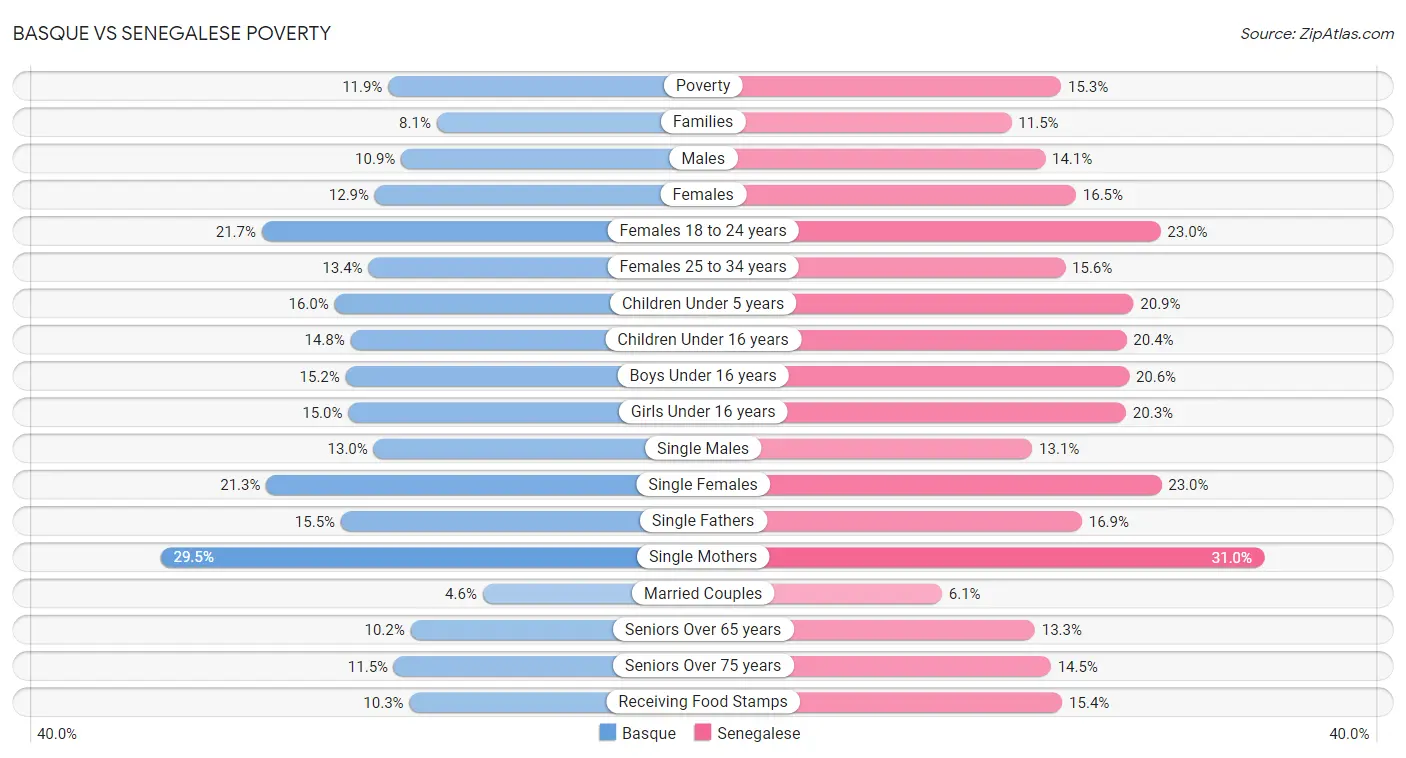
| Poverty Metric | Basque | Senegalese |
| Poverty | Excellent 11.9% | Tragic 15.3% |
| Families | Exceptional 8.1% | Tragic 11.5% |
| Males | Good 10.9% | Tragic 14.1% |
| Females | Excellent 12.9% | Tragic 16.5% |
| Females 18 to 24 years | Tragic 21.7% | Tragic 23.0% |
| Females 25 to 34 years | Average 13.4% | Tragic 15.6% |
| Children Under 5 years | Exceptional 16.0% | Tragic 20.9% |
| Children Under 16 years | Exceptional 14.8% | Tragic 20.4% |
| Boys Under 16 years | Exceptional 15.2% | Tragic 20.6% |
| Girls Under 16 years | Exceptional 15.0% | Tragic 20.3% |
| Single Males | Fair 13.0% | Poor 13.1% |
| Single Females | Fair 21.3% | Tragic 23.0% |
| Single Fathers | Exceptional 15.5% | Tragic 16.9% |
| Single Mothers | Fair 29.5% | Tragic 31.0% |
| Married Couples | Exceptional 4.6% | Tragic 6.1% |
| Seniors Over 65 years | Exceptional 10.2% | Tragic 13.3% |
| Seniors Over 75 years | Exceptional 11.5% | Tragic 14.5% |
| Receiving Food Stamps | Exceptional 10.3% | Tragic 15.4% |
Basque vs Senegalese Unemployment
When considering unemployment, the most significant differences between Basque and Senegalese communities in the United States are seen in male unemployment (5.0% compared to 6.4%, a difference of 29.0%), unemployment (5.0% compared to 6.2%, a difference of 25.1%), and unemployment among ages 16 to 19 years (17.3% compared to 21.0%, a difference of 21.4%). Conversely, both communities are more comparable in terms of unemployment among seniors over 65 years (5.1% compared to 5.1%, a difference of 0.34%), unemployment among women with children under 6 years (7.8% compared to 8.0%, a difference of 2.6%), and unemployment among ages 60 to 64 years (4.8% compared to 4.6%, a difference of 3.5%).
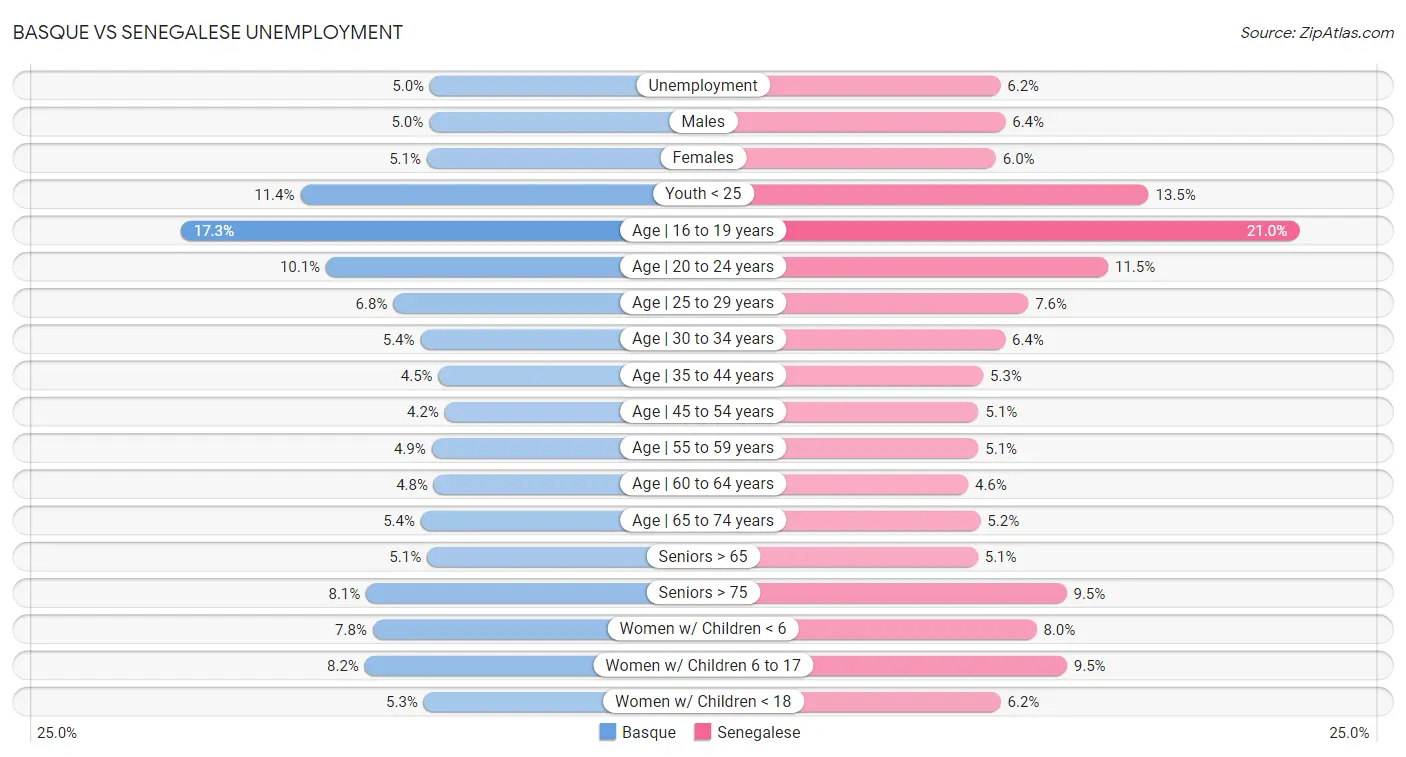
| Unemployment Metric | Basque | Senegalese |
| Unemployment | Exceptional 5.0% | Tragic 6.2% |
| Males | Exceptional 5.0% | Tragic 6.4% |
| Females | Excellent 5.1% | Tragic 6.0% |
| Youth < 25 | Excellent 11.4% | Tragic 13.5% |
| Age | 16 to 19 years | Excellent 17.3% | Tragic 21.0% |
| Age | 20 to 24 years | Excellent 10.1% | Tragic 11.5% |
| Age | 25 to 29 years | Fair 6.8% | Tragic 7.6% |
| Age | 30 to 34 years | Average 5.4% | Tragic 6.4% |
| Age | 35 to 44 years | Excellent 4.5% | Tragic 5.3% |
| Age | 45 to 54 years | Exceptional 4.2% | Tragic 5.1% |
| Age | 55 to 59 years | Fair 4.9% | Tragic 5.1% |
| Age | 60 to 64 years | Excellent 4.8% | Exceptional 4.6% |
| Age | 65 to 74 years | Fair 5.4% | Exceptional 5.2% |
| Seniors > 65 | Good 5.1% | Excellent 5.1% |
| Seniors > 75 | Exceptional 8.1% | Tragic 9.5% |
| Women w/ Children < 6 | Fair 7.8% | Tragic 8.0% |
| Women w/ Children 6 to 17 | Exceptional 8.2% | Tragic 9.5% |
| Women w/ Children < 18 | Excellent 5.3% | Tragic 6.2% |
Basque vs Senegalese Labor Participation
When considering labor participation, the most significant differences between Basque and Senegalese communities in the United States are seen in in labor force | age 16-19 (39.3% compared to 35.9%, a difference of 9.5%), in labor force | age > 16 (64.2% compared to 66.7%, a difference of 3.9%), and in labor force | age 20-24 (76.5% compared to 74.8%, a difference of 2.3%). Conversely, both communities are more comparable in terms of in labor force | age 45-54 (82.0% compared to 82.4%, a difference of 0.48%), in labor force | age 20-64 (78.7% compared to 79.7%, a difference of 1.2%), and in labor force | age 35-44 (83.6% compared to 84.9%, a difference of 1.6%).

| Labor Participation Metric | Basque | Senegalese |
| In Labor Force | Age > 16 | Tragic 64.2% | Exceptional 66.7% |
| In Labor Force | Age 20-64 | Tragic 78.7% | Good 79.7% |
| In Labor Force | Age 16-19 | Exceptional 39.3% | Poor 35.9% |
| In Labor Force | Age 20-24 | Exceptional 76.5% | Fair 74.8% |
| In Labor Force | Age 25-29 | Tragic 83.4% | Exceptional 85.0% |
| In Labor Force | Age 30-34 | Tragic 84.0% | Exceptional 85.4% |
| In Labor Force | Age 35-44 | Tragic 83.6% | Exceptional 84.9% |
| In Labor Force | Age 45-54 | Tragic 82.0% | Tragic 82.4% |
Basque vs Senegalese Family Structure
When considering family structure, the most significant differences between Basque and Senegalese communities in the United States are seen in single mother households (5.7% compared to 8.2%, a difference of 43.7%), married-couple households (48.4% compared to 38.6%, a difference of 25.7%), and births to unmarried women (29.7% compared to 36.8%, a difference of 23.6%). Conversely, both communities are more comparable in terms of divorced or separated (12.6% compared to 12.6%, a difference of 0.38%), average family size (3.19 compared to 3.21, a difference of 0.91%), and family households with children (27.7% compared to 26.6%, a difference of 4.0%).

| Family Structure Metric | Basque | Senegalese |
| Family Households | Excellent 64.7% | Tragic 59.8% |
| Family Households with Children | Good 27.7% | Tragic 26.6% |
| Married-couple Households | Exceptional 48.4% | Tragic 38.6% |
| Average Family Size | Tragic 3.19 | Fair 3.21 |
| Single Father Households | Tragic 2.5% | Excellent 2.3% |
| Single Mother Households | Exceptional 5.7% | Tragic 8.2% |
| Currently Married | Exceptional 48.1% | Tragic 40.6% |
| Divorced or Separated | Tragic 12.6% | Tragic 12.6% |
| Births to Unmarried Women | Exceptional 29.7% | Tragic 36.8% |
Basque vs Senegalese Vehicle Availability
When considering vehicle availability, the most significant differences between Basque and Senegalese communities in the United States are seen in no vehicles in household (7.8% compared to 19.8%, a difference of 154.4%), 4 or more vehicles in household (8.4% compared to 4.3%, a difference of 95.2%), and 3 or more vehicles in household (24.3% compared to 14.2%, a difference of 70.5%). Conversely, both communities are more comparable in terms of 1 or more vehicles in household (92.4% compared to 80.4%, a difference of 15.0%), 2 or more vehicles in household (61.4% compared to 44.2%, a difference of 38.8%), and 3 or more vehicles in household (24.3% compared to 14.2%, a difference of 70.5%).

| Vehicle Availability Metric | Basque | Senegalese |
| No Vehicles Available | Exceptional 7.8% | Tragic 19.8% |
| 1+ Vehicles Available | Exceptional 92.4% | Tragic 80.4% |
| 2+ Vehicles Available | Exceptional 61.4% | Tragic 44.2% |
| 3+ Vehicles Available | Exceptional 24.3% | Tragic 14.2% |
| 4+ Vehicles Available | Exceptional 8.4% | Tragic 4.3% |
Basque vs Senegalese Education Level
When considering education level, the most significant differences between Basque and Senegalese communities in the United States are seen in no schooling completed (1.8% compared to 2.3%, a difference of 25.6%), college, under 1 year (67.6% compared to 63.6%, a difference of 6.2%), and college, 1 year or more (60.9% compared to 58.2%, a difference of 4.8%). Conversely, both communities are more comparable in terms of bachelor's degree (37.7% compared to 37.5%, a difference of 0.52%), nursery school (98.2% compared to 97.7%, a difference of 0.53%), and kindergarten (98.2% compared to 97.7%, a difference of 0.54%).
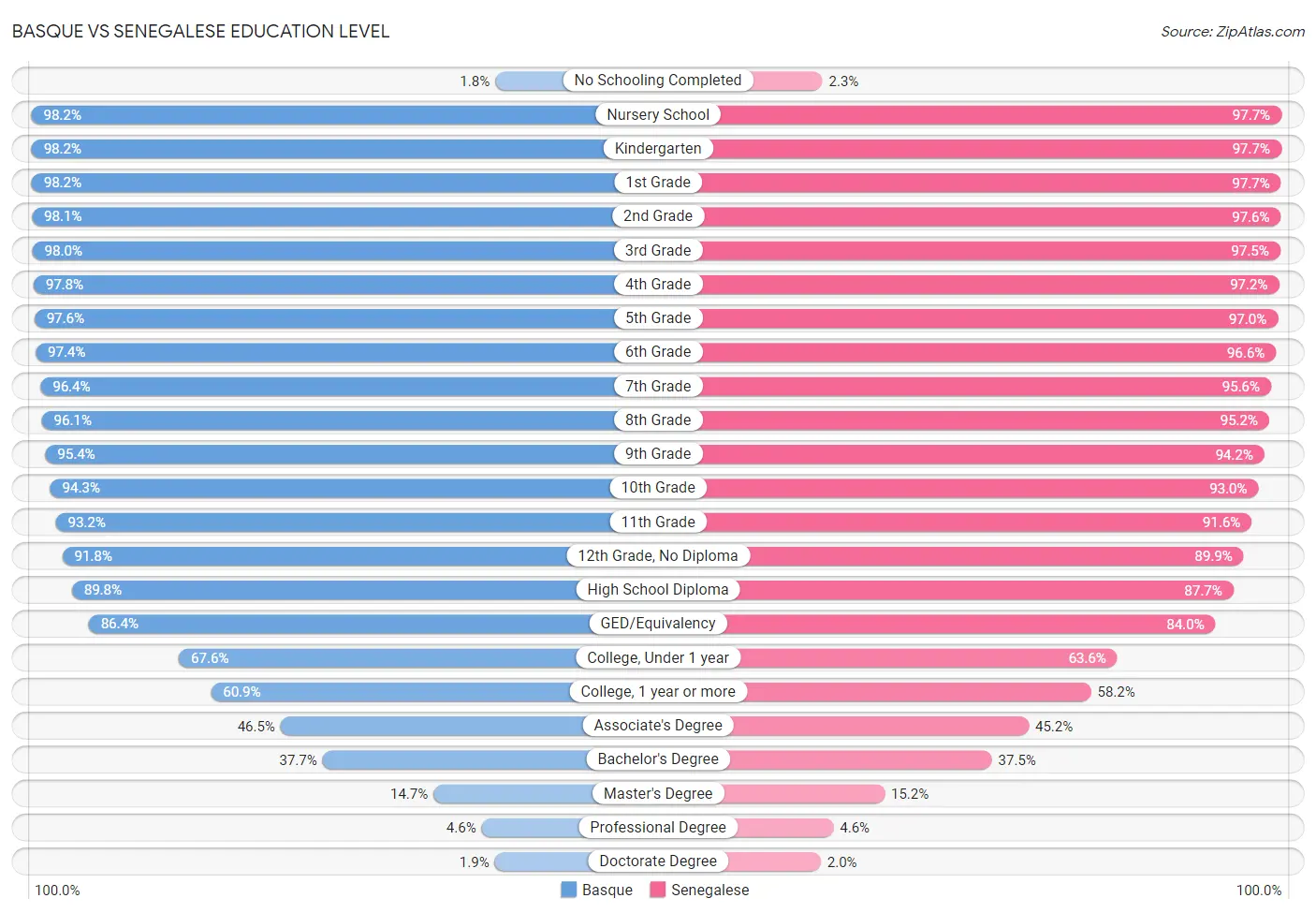
| Education Level Metric | Basque | Senegalese |
| No Schooling Completed | Exceptional 1.8% | Tragic 2.3% |
| Nursery School | Exceptional 98.2% | Tragic 97.7% |
| Kindergarten | Exceptional 98.2% | Tragic 97.7% |
| 1st Grade | Exceptional 98.2% | Tragic 97.7% |
| 2nd Grade | Exceptional 98.1% | Tragic 97.6% |
| 3rd Grade | Exceptional 98.0% | Tragic 97.5% |
| 4th Grade | Exceptional 97.8% | Tragic 97.2% |
| 5th Grade | Exceptional 97.6% | Tragic 97.0% |
| 6th Grade | Exceptional 97.4% | Tragic 96.6% |
| 7th Grade | Excellent 96.4% | Tragic 95.6% |
| 8th Grade | Exceptional 96.1% | Tragic 95.2% |
| 9th Grade | Exceptional 95.4% | Tragic 94.2% |
| 10th Grade | Exceptional 94.3% | Tragic 93.0% |
| 11th Grade | Exceptional 93.2% | Tragic 91.6% |
| 12th Grade, No Diploma | Exceptional 91.8% | Tragic 89.9% |
| High School Diploma | Excellent 89.8% | Tragic 87.7% |
| GED/Equivalency | Good 86.4% | Tragic 84.0% |
| College, Under 1 year | Exceptional 67.6% | Tragic 63.6% |
| College, 1 year or more | Excellent 60.9% | Poor 58.2% |
| Associate's Degree | Average 46.5% | Fair 45.2% |
| Bachelor's Degree | Average 37.7% | Average 37.5% |
| Master's Degree | Fair 14.7% | Good 15.2% |
| Professional Degree | Excellent 4.6% | Good 4.6% |
| Doctorate Degree | Good 1.9% | Excellent 2.0% |
Basque vs Senegalese Disability
When considering disability, the most significant differences between Basque and Senegalese communities in the United States are seen in hearing disability (3.6% compared to 2.6%, a difference of 36.4%), disability age under 5 (1.3% compared to 1.2%, a difference of 15.3%), and cognitive disability (17.1% compared to 19.0%, a difference of 11.2%). Conversely, both communities are more comparable in terms of disability age over 75 (47.6% compared to 47.9%, a difference of 0.74%), disability (12.2% compared to 12.1%, a difference of 0.89%), and female disability (12.4% compared to 12.8%, a difference of 3.6%).
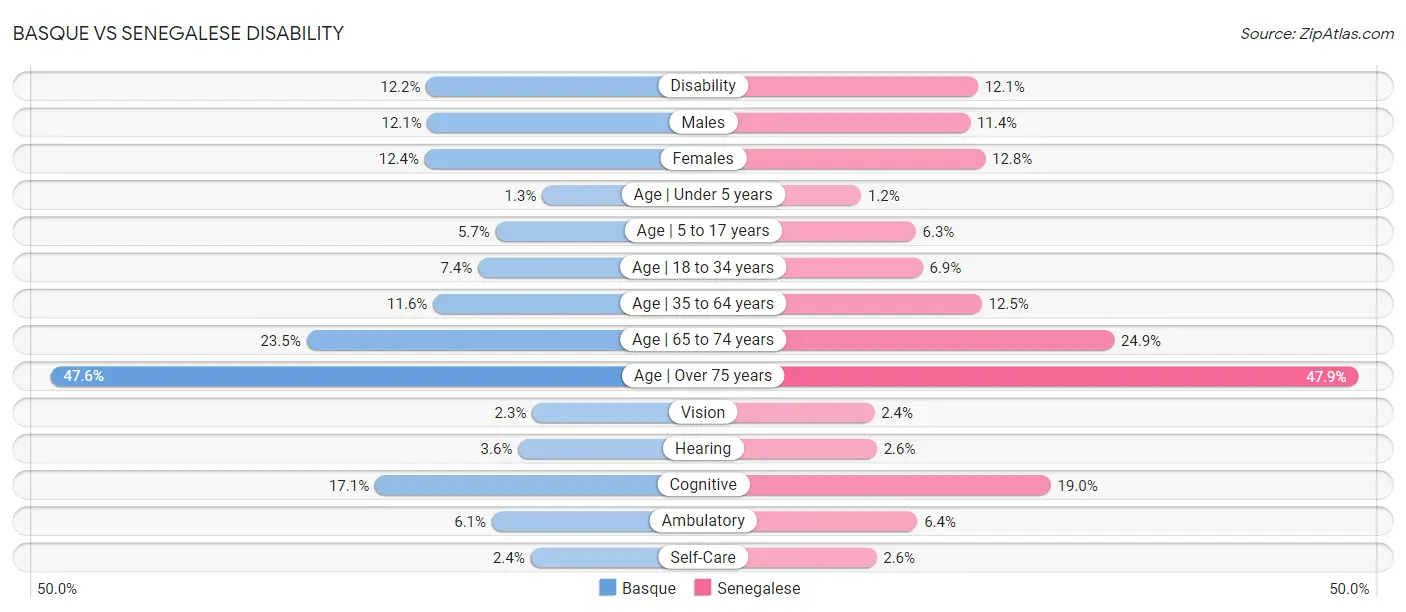
| Disability Metric | Basque | Senegalese |
| Disability | Tragic 12.2% | Tragic 12.1% |
| Males | Tragic 12.1% | Fair 11.4% |
| Females | Poor 12.4% | Tragic 12.8% |
| Age | Under 5 years | Tragic 1.3% | Exceptional 1.2% |
| Age | 5 to 17 years | Poor 5.7% | Tragic 6.3% |
| Age | 18 to 34 years | Tragic 7.4% | Tragic 6.9% |
| Age | 35 to 64 years | Poor 11.6% | Tragic 12.5% |
| Age | 65 to 74 years | Fair 23.5% | Tragic 24.9% |
| Age | Over 75 years | Fair 47.6% | Poor 47.9% |
| Vision | Tragic 2.3% | Tragic 2.4% |
| Hearing | Tragic 3.6% | Exceptional 2.6% |
| Cognitive | Excellent 17.1% | Tragic 19.0% |
| Ambulatory | Good 6.1% | Tragic 6.4% |
| Self-Care | Good 2.4% | Tragic 2.6% |